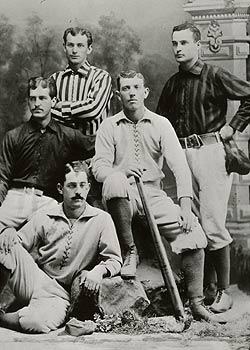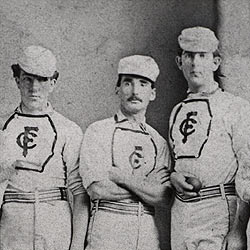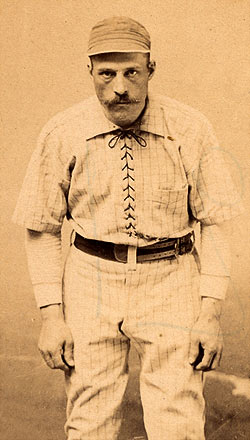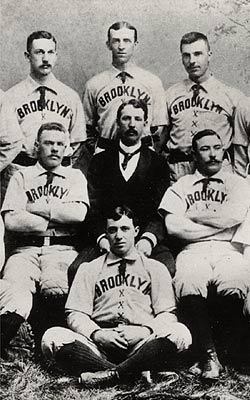 |
|
|
Jerseys
|
|
|
|
Taking the Field Wearing a ShieldThe shield-front jersey style first gained popularity as the baseball craze boomed in the late-1850s. Many of the leading clubs of the 1860s and 1870s wore the style that was reminiscent of volunteer fire company uniforms. Though sporting goods supplier A.G. Spalding & Bros. advertised the flannel “Fancy Shield Shirt” as late as 1893, few baseball clubs wore the style after the mid-1870s. The Boston Beaneaters revived the shield-front uniforms in 1897, but by the turn of the century the old-fashioned style was abandoned for good. At left: Fred Cone, Bob Addy and A.G. Spalding of the Rockford (Illinois) Forest Citys donning shield-front jerseys, 1869
|

|
Running the Bases Wearing LacesThe late 1870s saw the introduction of the laced-front jersey. Styles varied, with some shirts featuring lacing that ran the entire length of the shirt, while others had lacing for just the top portion of the jersey. Laced-front jerseys remained popular through the 1890s, but by 1901 only two of 16 major league clubs were wearing the style. Ten years later, laces on shirts had disappeared altogether. At left: Pete Browning of the American Association Louisville Colonels, c. 1887
|
Right on the ButtonThough button-down jerseys were first advertised in the mid-1880s, the style had gained popularity earlier in the decade and was probably first worn on the diamond in the 1850s. Ballclubs quickly adopted the style and, by the turn of the century, it was rare to see a baseball uniform that didn’t feature a button-down jersey.
|
|

|
Clown CostumesPerhaps the boldest experiment with the baseball uniform came in 1882, when the rules of the game called for multi-colored uniforms designed to denote each player’s position. When the members of a ballclub took the field, no two men were wearing the same uniform. Shortstops, for example, were required to wear maroon shirts and caps, while first basemen dressed like candy canes in scarlet-and-white-striped caps and jerseys. Regardless of position, the 1882 rules stipulated that each player wear white pants, a white belt and a white tie. The only way the fans could tell which club was which was by looking at the players’ stockings, as each club wore uniquely colored socks. The rulebook called for Buffalo to wear gray stockings, while Cleveland donned navy blue hose. Not surprisingly, Chicago wore white stockings and Boston dressed in red socks. No doubt the wild color schemes caused mass confusion on the field and in the stands, and so the experimental uniforms, derisively called “clown costumes,” were abandoned in mid-season. At left: Members of the American Association Cincinnati Red Stockings in “clown costumes,” 1882
|
|
|
Pinstripes and ChecksNumerous 19th-century baseball clubs had adorned themselves with striped uniforms, some stripes wider than others, but true “pinstripes” were not introduced until 1888. That season three big league clubs, Washington and Detroit of the National League and Brooklyn of the American Association, adopted the dapper pattern. The two National league clubs finished poorly in 1888, and the following season they reverted to more traditional uniforms. Donning pinstripes, Brooklyn improved from a sixth-place finish in 1887 to a second place showing in 1888. Looking to improve in 1889, the club added more stripes … this time in a horizontal direction. The result was the first checked uniform in big league history and Brooklyn won the pennant. For reasons unknown, Brooklyn discarded their cross-hatched duds for the 1890 season, and the club dropped to the cellar. Pinstripes and checked uniforms both returned to big league baseball in 1907. For that season, the Boston Nationals (later known as the Braves) adopted pinstripes, while the Brooklyn Superbas (later known as the Dodgers) wore checked jerseys. The team best known for their pinstripes, the New York Yankees, first tried the style in 1912 and adopted pinstripes for good beginning in 1915. At left: Joe Visner of the American Association Brooklyn Bridegrooms, 1889
|
Wearing the CollarThroughout the 19th century, baseball jerseys featured a full collar. The first collarless jersey was introduced to the big leagues by the New York Giants in 1906. Over the next few decades, numerous collar styles were used. The Chicago Cubs of 1909 were the first to don a short “standing” or “military” collar, a style that proved extremely popular throughout the 1910s. A V-neck collar with a slight extension (essentially a compromise between the collarless and “military” collar styles) was introduced by the New York Giants in 1908, and by the 1920s most every club had adopted the look. By the 1930s, however, the simple collarless jersey took over as the “industry standard.” Other than a brief revival of a faux full collar by the Chicago White Sox in the late 1970s, the full-collared jersey was last seen on a big league uniform in 1913, when the Chicago Cubs “wore the collar.” Zippity-Do DudsThe zipper, in its earliest form, was invented in 1891, but it was not until the 1930s that the handy fastener was added to the baseball uniform. The 1937 Cubs were the first big league club to switch from a button-down jersey to the zipper-front style, but other teams soon followed Chicago’s lead. The zipper fad reached its peak in 1940 and ’41, when half of all big league clubs had zippered jerseys. The zipper was an integral part of the tunic-dress uniform worn during the 12-year run of the All-American Girls Professional Baseball League (AAGPBL), as the device was used to cinch the uniform snugly around the waist. The last major league club to wear a zipper-front jersey was the Philadelphia Phillies in 1986. Weighty WoolCan you imagine playing baseball during the hot and humid summertime in a wool uniform? From the first baseball uniforms of the mid-19th century to well into the 1940s, the cloth of choice was flannel, made from wool or a wool-cotton blend. During the 1930s and ’40s, some clubs donned satin uniforms for night games, as the shiny weave stood out under the glare of electric lights. However, the style never quite caught on. Light-weight blends of wool with synthetic fibers were an improvement to the uniform, but the greatest leap forward occurred in 1970 when the Pittsburgh Pirates introduced comfortable and more durable double-knit uniforms to big league ball. Today, synthetic double-knits are used throughout all levels of baseball.
|
|
|
|
Dressed in a VestIn 1940, the Chicago Cubs unveiled a bold new look in baseball uniforms: a lightweight flannel vest worn over a knitted undershirt. The vest, designed by club president Philip K. Wrigley, allowed for greater freedom of motion for players’ arms and shoulders. Though the Cubs abandoned the innovation just three seasons later, the style has enjoyed a number of revivals over the years. Today, multiple clubs wear sleeveless jerseys, either as part of their primary or alternate home uniform. At left: Chicago Cubs outfielder Bill Nicholson, 1940
|
Pittsburgh Pirates Pull-OversPull-over jerseys (shirts without buttons, laces or fasteners of any kind) were used sporadically during the 19th century, but it is doubtful they were ever adopted by a major league club. The style first appeared in the big leagues on July 16, 1970, when the Pittsburgh Pirates unveiled their brand new ballpark, Three Rivers Stadium. At the same time, the club unveiled brand new uniforms that featured the buttonless pull-over jersey. The revolutionary duds were also the first made from a cotton-nylon blend and the first to feature beltless pants. The bold new look proved quite a success, with nearly ever major league club soon following suit. The pull-over jersey style lasted until 1993, when the Cincinnati Reds became the final team to return to the button-down style.
|
|
|
|
Accessories and Accoutrements
At left: Members of Brooklyn (National League) wearing ties, 1890
|
|
Dressed to the Nines: A History of the Baseball Uniform |
|



